Remote Sensing Estimation of Sea Surface Salinity from GOCI Measurements in the Southern Yellow Sea
Abstract
1. Introduction
2. Materials and Methods
2.1. Study Area
2.2. In Situ Data Collection
2.2.1. Measurement of Sea Surface Salinity
2.2.2. Measurement of Rrs(λ)
2.2.3. Measurement of Changjiang River Discharge
2.3. Satellite Data
2.4. Model Accuracy Evaluation
3. Results
3.1. In Situ Data Distribution
3.2. Development of SSS Model
3.3. Model Validation
3.3.1. Cross-Validation
3.3.2. Validation of Satellite-Derived SSS
3.3.3. Comparison with Other Published Models
3.4. Distribution Patterns of SSS in August in the SYS
3.5. Regional Difference of SSS in August in the SYS
4. Discussion
4.1. Rationality and Limitations of the Proposed SSS Model
4.2. Response of SSS to CRD
5. Conclusions
Author Contributions
Funding
Acknowledgments
Conflicts of Interest
References
- Fennel, K.; Hetland, R.; Feng, Y.; DiMarco, S. A coupled physical-biological model of the Northern Gulf of Mexico shelf: Model description, validation and analysis of phytoplankton variability. Biogeosciences 2011, 8, 1881–1899. [Google Scholar] [CrossRef]
- Xue, Z.; He, R.; Fennel, K.; Cai, W.-J.; Lohrenz, S.; Hopkinson, C. Modeling ocean circulation and biogeochemical variability in the Gulf of Mexico. Biogeosciences 2013, 10, 7219–7234. [Google Scholar] [CrossRef]
- Chen, S.; Hu, C. Estimating sea surface salinity in the northern Gulf of Mexico from satellite ocean color measurements. Remote. Sens. Environ. 2017, 201, 115–132. [Google Scholar] [CrossRef]
- Song, Q.; Zhang, J.; Cui, T.; Bao, Y. Retrieval of sea surface salinity with MERIS and MODIS data in the Bohai Sea. Remote. Sens. Environ. 2013, 136, 117–125. [Google Scholar]
- Burrage, D.; Wesson, J.; Miller, J. Deriving Sea Surface Salinity and Density Variations from Satellite and Aircraft Microwave Radiometer Measurements: Application to Coastal Plumes Using STARRS. IEEE Trans. Geosci. Remote. Sens. 2008, 46, 765–785. [Google Scholar] [CrossRef]
- Gabarró, C.; Vall-Llossera, M.; Font, J.; Camps, A. Determination of sea surface salinity and wind speed by L-band microwave radiometry from a fixed platform. Int. J. Remote. Sens. 2004, 25, 111–128. [Google Scholar] [CrossRef]
- Klein, L.A.; Swift, C.T. An improved model for the dielectric constant of sea water at microwave frequencies. IEEE Trans. Antennas Propag. 2003, 25, 104–111. [Google Scholar] [CrossRef]
- Maes, C.; Behringer, D. Using satellite-derived sea level and temperature profiles for determining the salinity variability: A new approach. J. Geophys. Res. Phys. 2000, 105, 8537–8547. [Google Scholar] [CrossRef]
- Marghany, M.; Hashim, M.; Cracknell, A.P. Modelling Sea Surface Salinity from MODIS Satellite Data. Hum. Cent. Comput. 2010, 6016, 545–556. [Google Scholar]
- Lagerloef, G.S.E.; Swift, C.T.; Levine, D.M. Sea Surface Salinity: The Next Remote Sensing Challenge. Oceanography 1995, 8, 44–50. [Google Scholar] [CrossRef]
- Font, J.; Camps, A.; Ballabrera-Poy, J. Microwave Aperture Synthesis Radiometry: Paving the Path for Sea Surface Salinity Measurement from Space; Springer Nature: Basingstoke, UK, 2008; pp. 223–238. [Google Scholar]
- Blume, H.J.C.; Kendall, B.M. Passive Microwave Measurements of Temperature and Salinity in Coastal Zones. IEEE Trans. Geosci. Remote Sens. 2007, GE-20, 394–404. [Google Scholar] [CrossRef]
- Talone, M.; Sabia, R.; Camps, A.; Vall-Llossera, M.; Gabarró, C.; Font, J. Sea surface salinity retrievals from HUT-2D L-band radiometric measurements. Remote. Sens. Environ. 2010, 114, 1756–1764. [Google Scholar] [CrossRef]
- Banks, C.J.; Gommenginger, C.P.; Srokosz, M.A.; Snaith, H.M. Validating SMOS Ocean Surface Salinity in the Atlantic With Argo and Operational Ocean Model Data. IEEE Trans. Geosci. Remote. Sens. 2012, 50, 1688–1702. [Google Scholar] [CrossRef]
- Camps, A.; Font, J.; Corbella, I.; Vall-Llossera, M.; Portabella, M.; Ballabrera-Poy, J.; Gonzalez, V.; Piles, M.; Aguasca, A.; Acevo, R.; et al. Review of the CALIMAS Team Contributions to European Space Agency’s Soil Moisture and Ocean Salinity Mission Calibration and Validation. Remote. Sens. 2012, 4, 1272–1309. [Google Scholar] [CrossRef]
- Reul, N.; Tenerelli, J.; Boutin, J.; Chapron, B.; Paul, F.; Brion, E.; Gaillard, F.; Archer, O. Overview of the First SMOS Sea Surface Salinity Products. Part I: Quality Assessment for the Second Half of 2010. IEEE Trans. Geosci. Remote Sens. 2012, 50, 1636–1647. [Google Scholar] [CrossRef]
- Tong, L.; Lagerloef, G.; Gierach, M.M.; Kao, Hs.; Yueh, S.; Dohan, K. Aquarius reveals salinity structure of tropical instability waves. Geophys. Res. Lett. 2012, 39, 12610. [Google Scholar]
- Vine, D.M.L.; de Matthaeis, P.; Ruf, C.S.; Chen, D.D. Aquarius RFI Detection and Mitigation Algorithm: Assessment and Examples. IEEE Trans. Geosci. Remote Sens. 2014, 52, 4574–4584. [Google Scholar] [CrossRef]
- Hoareau, N.; Umbert, M.; Martínez, J.; Turiel, A.; Ballabrera-Poy, J. On the potential of data assimilation to generate SMOS-Level 4 maps of sea surface salinity. Remote. Sens. Environ. 2014, 146, 188–200. [Google Scholar] [CrossRef]
- Khorram, S. Remote sensing of salinity in the San Francisco Bay Delta. Remote. Sens. Environ. 1982, 12, 15–22. [Google Scholar] [CrossRef]
- Font, J.; Camps, A.; Borges, A.; Martin-Neira, M.; Boutin, J.; Reul, N.; Kerr, Y.H.; Hahne, A.; Mecklenburg, S. SMOS: The challenging sea surface salinity measurement from space. Proc. IEEE 2010, 98, 649–665. [Google Scholar] [CrossRef]
- Kerr, Y.H.; Waldteufel, P.; Wigneron, J.-P.; Delwart, S.; Cabot, F.; Boutin, J.; Escorihuela, M.-J.; Font, J.; Reul, N.; Gruhier, C.; et al. The SMOS mission: new tool for monitoring key elements of the global water cycle. Proc. IEEE 2010, 98, 666–687. [Google Scholar] [CrossRef]
- Urquhart, E.A.; Zaitchik, B.F.; Hoffman, M.J.; Guikema, S.D.; Geiger, E.F. Remotely sensed estimates of surface salinity in the Chesapeake Bay: A statistical approach. Remote. Sens. Environ. 2012, 123, 522–531. [Google Scholar] [CrossRef]
- Mckeon, J.B.; Rogers, R.H.; Smith, V.E. Production of a water quality map of Saginaw Bay by computer processing of LANDSAT-2 data. In Proceedings of the 11th International Symposium on Remote Sensing of Environment, 25–29 April 1977, Ann Arbor, MI, USA; Volume 2, pp. 1045–1054.
- Wong, M.S.; Lee, K.H.; Kim, Y.J.; Nichol, J.E.; Li, Z.; Emerson, N. Modeling of suspended solids and sea surface salinity in Hong Kong using Aqua/MODIS satellite images. J. Remote Sens. 2007, 23, 161–169. [Google Scholar]
- Marghany, M.; Hashim, M. A numerical method for retrieving sea surface salinity from MODIS satellite data. Int. J. Phys. Sci. 2011, 6, 3116–3125. [Google Scholar]
- Marghany, M.; Hashim, M. Retrieving seasonal sea surface salinity from MODIS satellite data using a Box-Jenkins algorithm. In Proceedings of the IGARSS 2011—2011 IEEE International Geoscience and Remote Sensing Symposium, Vancouver, BC, Canada, 24–29 July 2011. [Google Scholar]
- Yu, X.; Xiao, B.; Liu, X.; Wang, Y.; Cui, B.; Liu, X. Retrieval of remotely sensed sea surface salinity using MODIS data in the Chinese Bohai Sea. Int. J. Remote. Sens. 2017, 38, 7357–7373. [Google Scholar] [CrossRef]
- Bai, Y.; Pan, D.; Cai, W.-J.; He, X.; Wang, D.; Tao, B.; Zhu, Q. Remote sensing of salinity from satellite-derived CDOM in the Changjiang River dominated East China Sea. J. Geophys. Res. Oceans 2013, 118, 227–243. [Google Scholar] [CrossRef]
- Bowers, D.; Harker, G.; Smith, P.; Tett, P. Optical Properties of a Region of Freshwater Influence (The Clyde Sea). Estuarine, Coast. Shelf Sci. 2000, 50, 717–726. [Google Scholar] [CrossRef]
- Bricaud, A.; Morel, A.; Prieur, L. Absorption by dissolved organic matter of the sea (yellow substance) in the UV and visible domains1. Limnol. Oceanogr. 1981, 26, 43–53. [Google Scholar] [CrossRef]
- Garver, S.A.; Siegel, D.A. Inherent optical property inversion of ocean color spectra and its biogeochemical interpretation: 1. Time series from the Sargasso Sea. J. Geophys. Res. Phys. 1997, 102, 18607–18625. [Google Scholar] [CrossRef]
- D’Sa, E.J.; Hu, C.; Muller-Karger, F.E.; Carder, K.L. Estimation of colored dissolved organic matter and salinity fields in case 2 waters using SeaWiFS: Examples from Florida Bay and Florida Shelf. J. Earth Syst. Sci. 2002, 111, 197–207. [Google Scholar] [CrossRef]
- Ryu, J.-H.; Han, H.-J.; Cho, S.; Park, Y.-J.; Ahn, Y.-H. Overview of geostationary ocean color imager (GOCI) and GOCI data processing system (GDPS). Ocean Sci. J. 2012, 47, 223–233. [Google Scholar] [CrossRef]
- Yuan, Y.; Qiu, Z.; Sun, D.; Wang, S.; Yue, X. Daytime sea fog retrieval based on GOCI data: A case study over the Yellow Sea. Opt. Express 2016, 24, 787–801. [Google Scholar] [CrossRef] [PubMed]
- Sun, D.; Huan, Y.; Qiu, Z.; Hu, C.; Wang, S.; He, Y. Remote-Sensing Estimation of Phytoplankton Size Classes from GOCI Satellite Measurements in Bohai Sea and Yellow Sea. J. Geophys. Res. Oceans 2017, 122, 8309–8325. [Google Scholar] [CrossRef]
- Sun, D.; Qiu, Z.; Hu, C.; Wang, S.; Wang, L.; Zheng, L.; Peng, T.; He, Y. A hybrid method to estimate suspended particle sizes from satellite measurements over Bohai Sea and Yellow Sea. J. Geophys. Res. Oceans 2016, 121, 6742–6761. [Google Scholar] [CrossRef]
- Beardsley, R.; Limeburner, R.; Yu, H.; Cannon, G. Discharge of the Changjiang (Yangtze River) into the East China Sea. Cont. Shelf Res. 1985, 4, 57–76. [Google Scholar] [CrossRef]
- Pang, J.; Jiang, M.; Fulin, L.I. Changes and Development Trend of Runoff, Sediment Discharge and Coastline of the Yellow River Estuary. Trans. Oceanol. Limnol. 2000, 4, 1–6. [Google Scholar]
- Fan, H.; Huang, H. Response of coastal marine eco-environment to river fluxes into the sea: A case study of the Huanghe (Yellow) River mouth and adjacent waters. Mar. Environ. Res. 2008, 65, 378–387. [Google Scholar] [CrossRef] [PubMed]
- Ichikawa, H.; Chaen, M. Seasonal variation of heat and freshwater transports by the Kuroshio in the East China Sea. J. Mar. Syst. 2000, 24, 119–129. [Google Scholar] [CrossRef]
- Chen, Z.; Li, J.; Shen, H.; Zhanghua, W. Yangtze River of China: historical analysis of discharge variability and sediment flux. Geomorphology 2001, 41, 77–91. [Google Scholar] [CrossRef]
- Lee, H.J.; Jung, K.T.; So, J.K.; Chung, J.Y. A three-dimensional mixed finite-difference Galerkin function model for the oceanic circulation in the Yellow Sea and the East China Sea in the presence of M2 tide. Cont. Shelf Res. 2002, 22, 67–91. [Google Scholar] [CrossRef]
- Hu, D.X.; Wang, Q. Interannual variability of the southern Yellow Sea Cold Water Mass. Chin. J. Oceanol. Limnol. 2004, 22, 231–236. [Google Scholar]
- Ma, J.; Qiao, F.; Xia, C.; Kim, C.S. Effects of the Yellow Sea Warm Current on the winter temperature distribution in a numerical model. J. Geophys. Res. Oceans 2006, 111. [Google Scholar] [CrossRef]
- Guan, B.X. Patterns and Structures of the Currents in Bohai, Huanghai and East China Seas. In Oceanology of China Seas; Springer: Dordrecht, The Netherlands, 1994; pp. 17–26. [Google Scholar]
- Pegau, W.S.; Gray, D.; Zaneveld, J.R.V. Absorption and attenuation of visible and near-infrared light in water: The dependence on temperature and salinity. Appl. Opt. 1997, 36, 6035–6046. [Google Scholar] [CrossRef] [PubMed]
- Sullivan, J.M.; Twardowski, M.S.; Zaneveld, J.R.V.; Moore, C.M.; Barnard, A.H.; Donaghay, P.L.; Rhoades, B. Hyperspectral temperature and salt dependencies of absorption by water and heavy water in the 400–750 nm spectral range. Appl. Opt. 2006, 45, 5294–5309. [Google Scholar] [CrossRef] [PubMed]
- Hirawake, T.; Takao, S.; Horimoto, N.; Ishimaru, T.; Yamaguchi, Y.; Fukuchi, M. A phytoplankton absorption-based primary productivity model for remote sensing in the Southern Ocean. Polar Boil. 2011, 34, 291–302. [Google Scholar] [CrossRef]
- Rudorff, N.D.M.; Frouin, R.; Kampel, M.; Goyens, C.; Mériaux, X.; Schieber, B.; Mitchell, B.G. Ocean-color radiometry across the Southern Atlantic and Southeastern Pacific: Accuracy and remote sensing implications. Remote. Sens. Environ. 2014, 149, 13–32. [Google Scholar] [CrossRef]
- Jiang, L.; Wang, M.; Ahn, J.-H.; Shi, W.; Son, S.; Park, Y.-J.; Ryu, J.-H. Ocean color products from the Korean Geostationary Ocean Color Imager (GOCI). Opt. Express 2013, 21, 3835. [Google Scholar]
- Wang, M.; Gordon, H.R. A simple, moderately accurate, atmospheric correction algorithm for SeaWiFS. Remote. Sens. Environ. 1994, 50, 231–239. [Google Scholar] [CrossRef]
- Xu, Y.J.; Wang, F. Development and application of a remote sensing-based salinity prediction model for a large estuarine lake in the US Gulf of Mexico coast. J. Hydrol. 2008, 360, 184–194. [Google Scholar]
- Salisbury, J.; VanDeMark, D.; Campbell, J.; Hunt, C.; Wisser, D.; Reul, N.; Chapron, B. Spatial and temporal coherence between Amazon River discharge, salinity, and light absorption by colored organic carbon in western tropical Atlantic surface waters. J. Geophys. Res. Phys. 2011, 116. [Google Scholar] [CrossRef]
- Kearns, M.; Ron, D. Algorithmic Stability and Sanity-Check Bounds for Leave-One-Out Cross-Validation. Neural Comput. 1999, 11, 1427–1453. [Google Scholar] [CrossRef] [PubMed]
- Bai, H.; Hu, D.; Chen, Y.; Wang, Q. Statistic characteristics of thermal structure in the southern Yellow Sea in summer. Chin. J. Oceanol. Limnol. 2004, 22, 33–39. [Google Scholar]
- Bowers, D.; Evans, D.; Thomas, D.; Ellis, K.; Williams, P.B.; Thomas, D. Interpreting the colour of an estuary. Estuar. Coast. Shelf Sci. 2004, 59, 13–20. [Google Scholar] [CrossRef]
- Blough, N.V.; Zafiriou, O.C.; Bonilla, J. Optical absorption spectra of waters from the Orinoco River outflow: Terrestrial input of colored organic matter to the Caribbean. J. Geophys. Res. Phys. 1993, 98, 2271–2278. [Google Scholar] [CrossRef]
- Ferrari, G.; Dowell, M. CDOM Absorption Characteristics with Relation to Fluorescence and Salinity in Coastal Areas of the Southern Baltic Sea. Estuar. Coast. Shelf Sci. 1998, 47, 91–105. [Google Scholar] [CrossRef]
- Hu, C.; Chen, Z.; Clayton, T.D.; Swarzenski, P.; Brock, J.C.; Muller–Karger, F.E. Assessment of estuarine water-quality indicators using MODIS medium-resolution bands: Initial results from Tampa Bay, FL. Remote. Sens. Environ. 2004, 93, 423–441. [Google Scholar] [CrossRef]
- Keith, D.; Yoder, J.; Freeman, S. Spatial and Temporal Distribution of Coloured Dissolved Organic Matter (CDOM) in Narragansett Bay, Rhode Island: Implications for Phytoplankton in Coastal Waters. Estuar. Coast. Shelf Sci. 2002, 55, 705–717. [Google Scholar] [CrossRef]
- Cui, T.; Zhang, J.; Groom, S.; Sun, L.; Smyth, T.; Sathyendranath, S. Validation of MERIS ocean-color products in the Bohai Sea: A case study for turbid coastal waters. Remote. Sens. Environ. 2010, 114, 2326–2336. [Google Scholar] [CrossRef]
- Wang, M.; Tang, J.; Shi, W. MODIS-derived ocean color products along the China east coastal region. Geophys. Res. Lett. 2007, 34, 306–316. [Google Scholar] [CrossRef]
- Horner-Devine, A.R.; Hetland, R.D.; Macdonald, D.G. Mixing and Transport in Coastal River Plumes. Annu. Rev. Mech. 2015, 47, 569–594. [Google Scholar] [CrossRef]
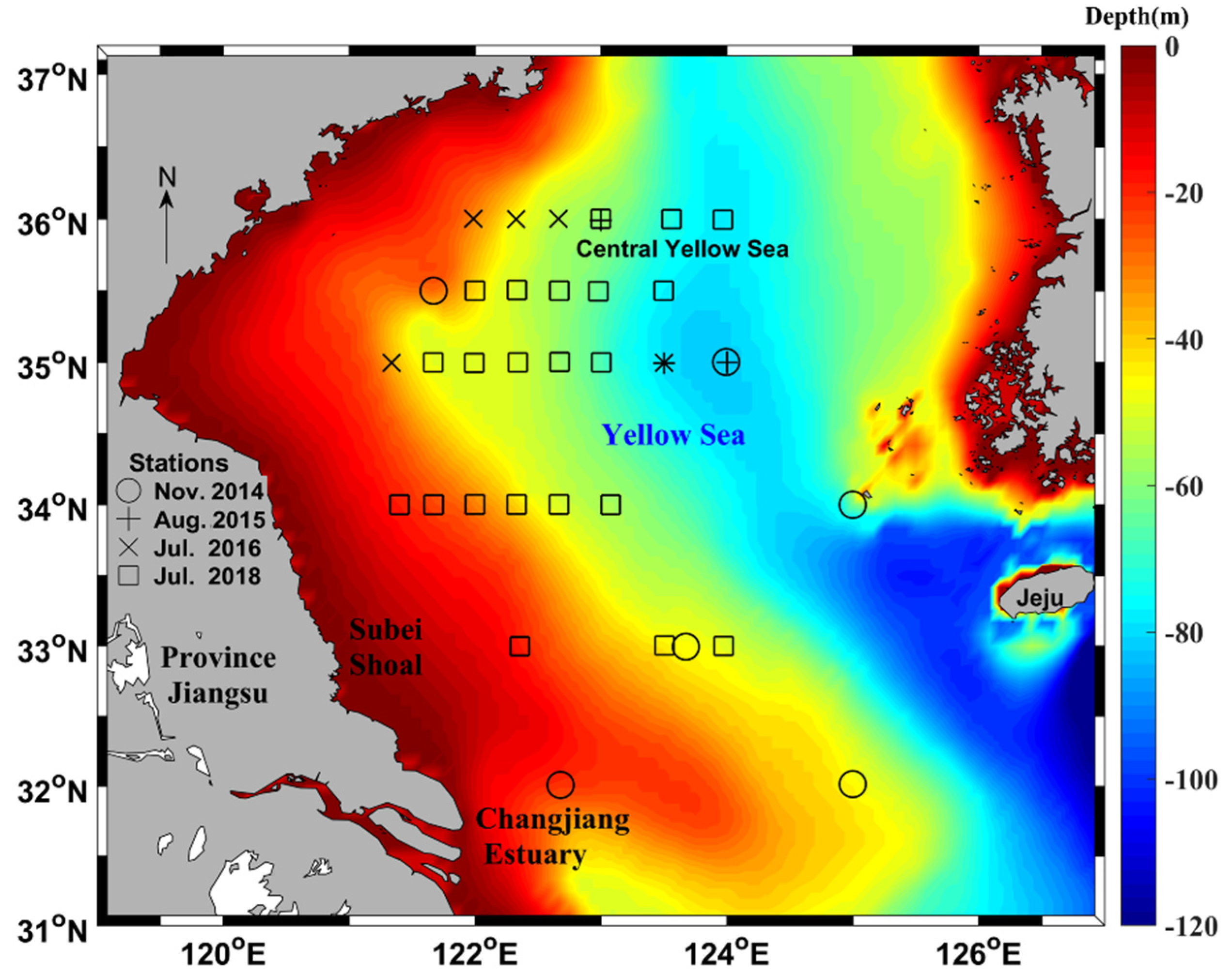
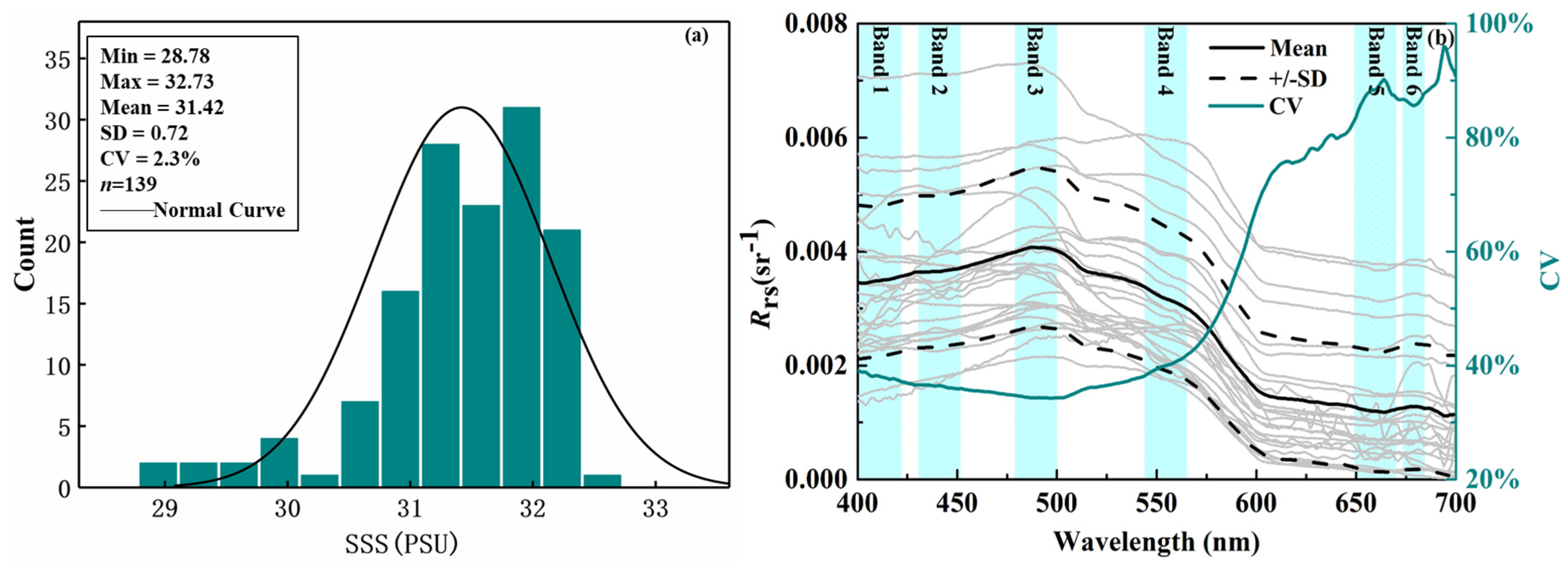
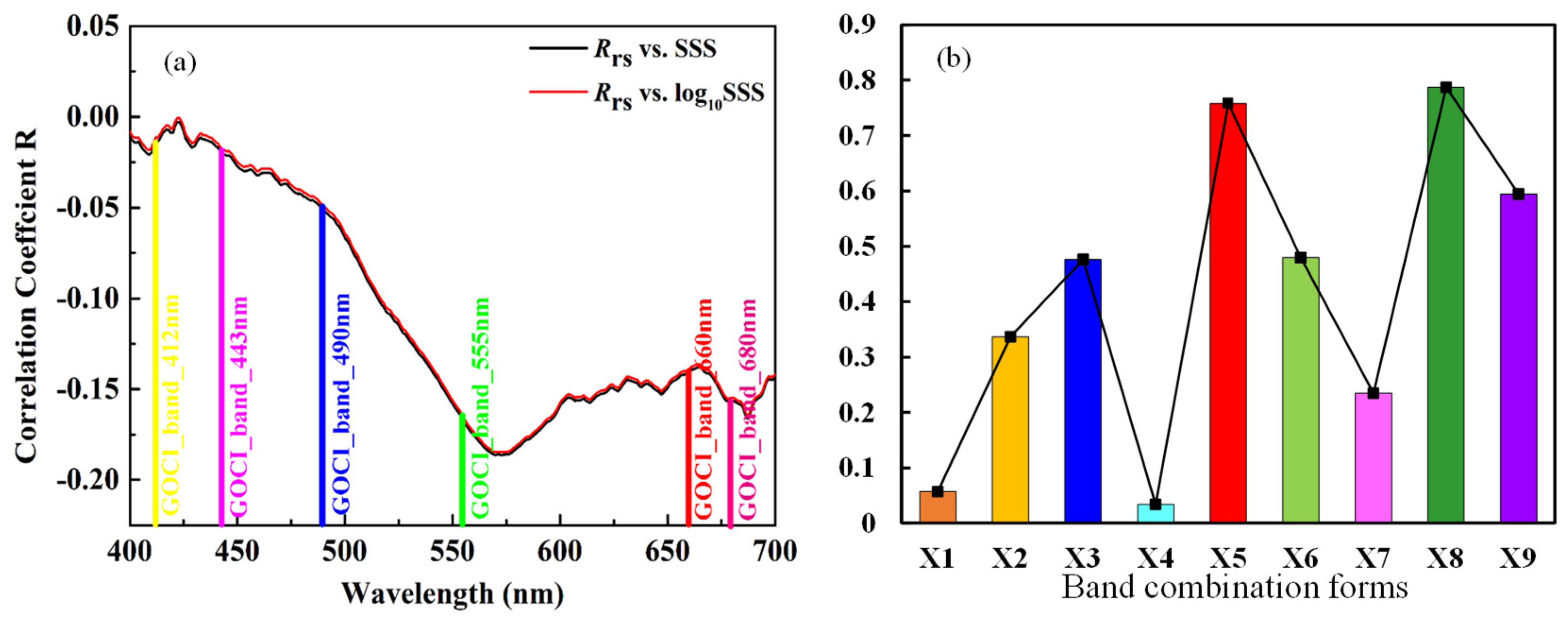
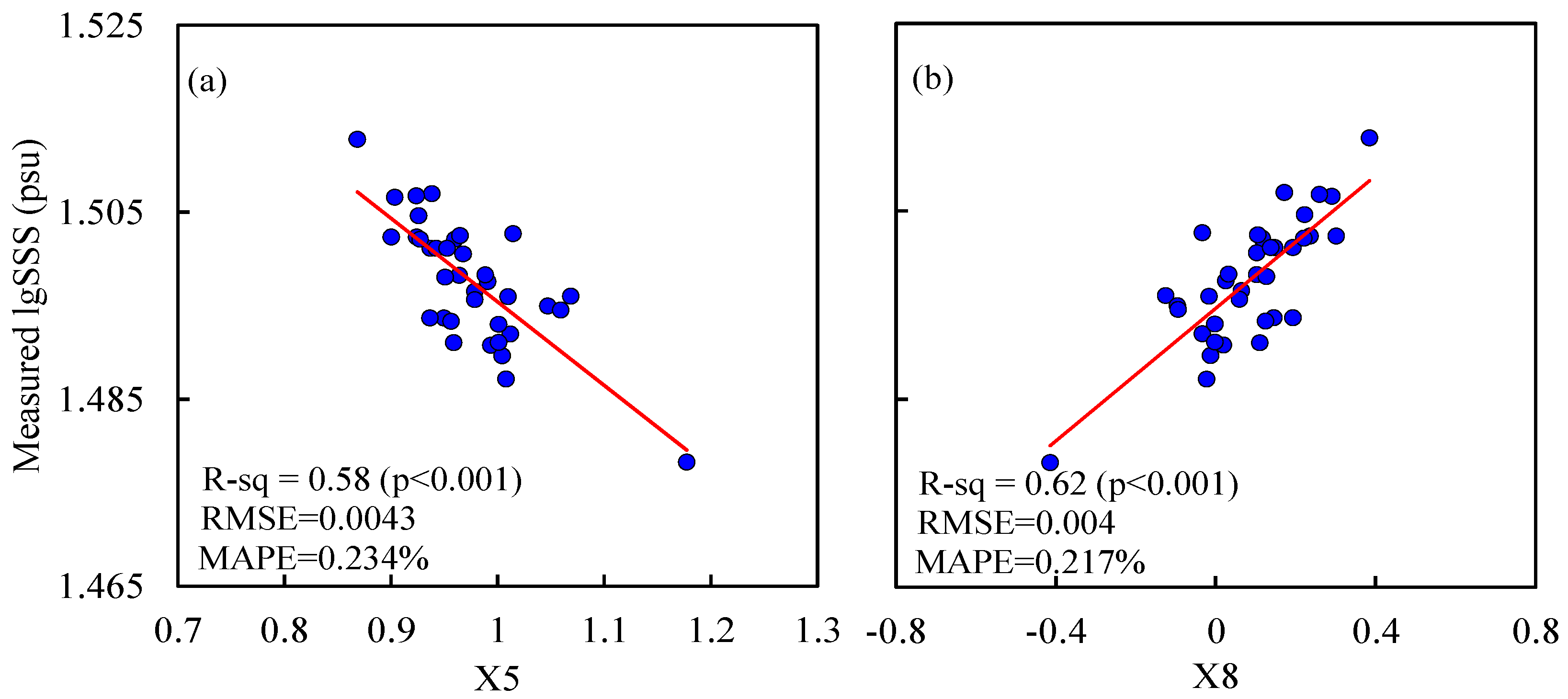

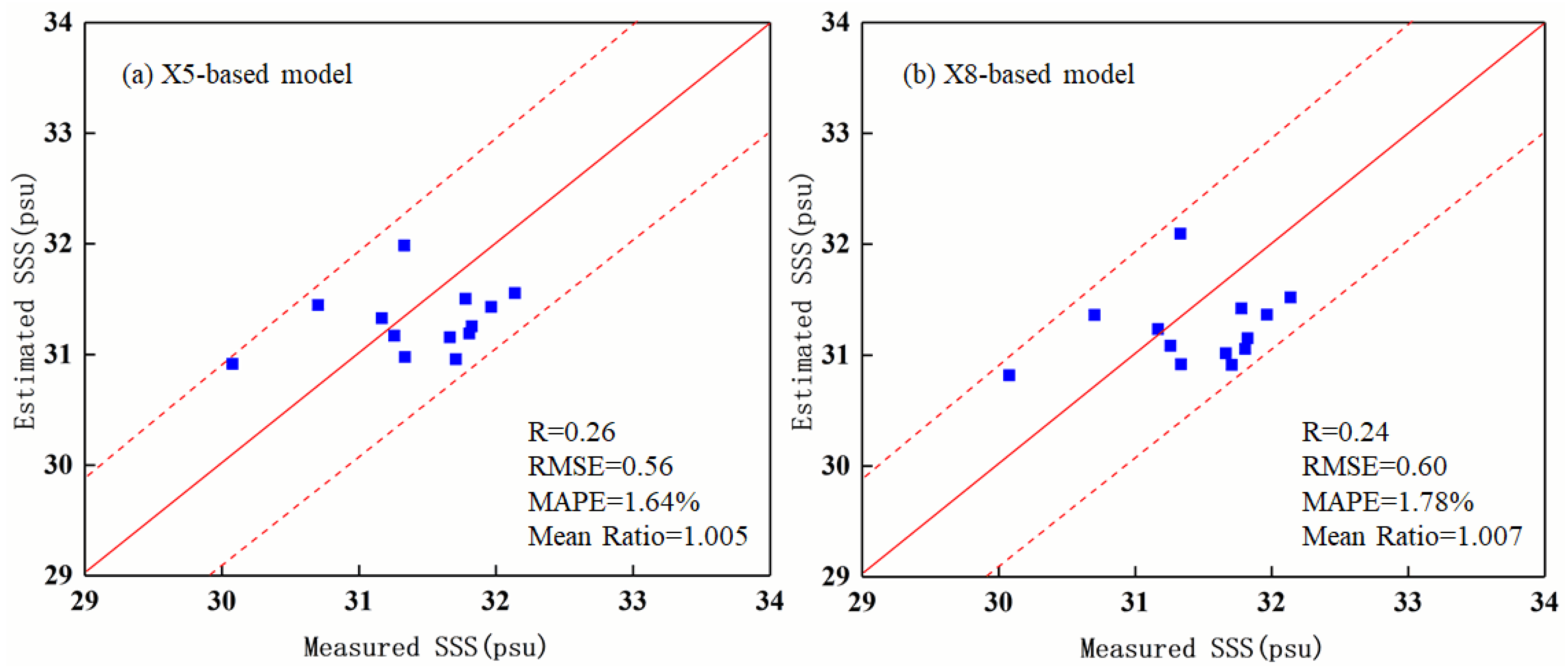

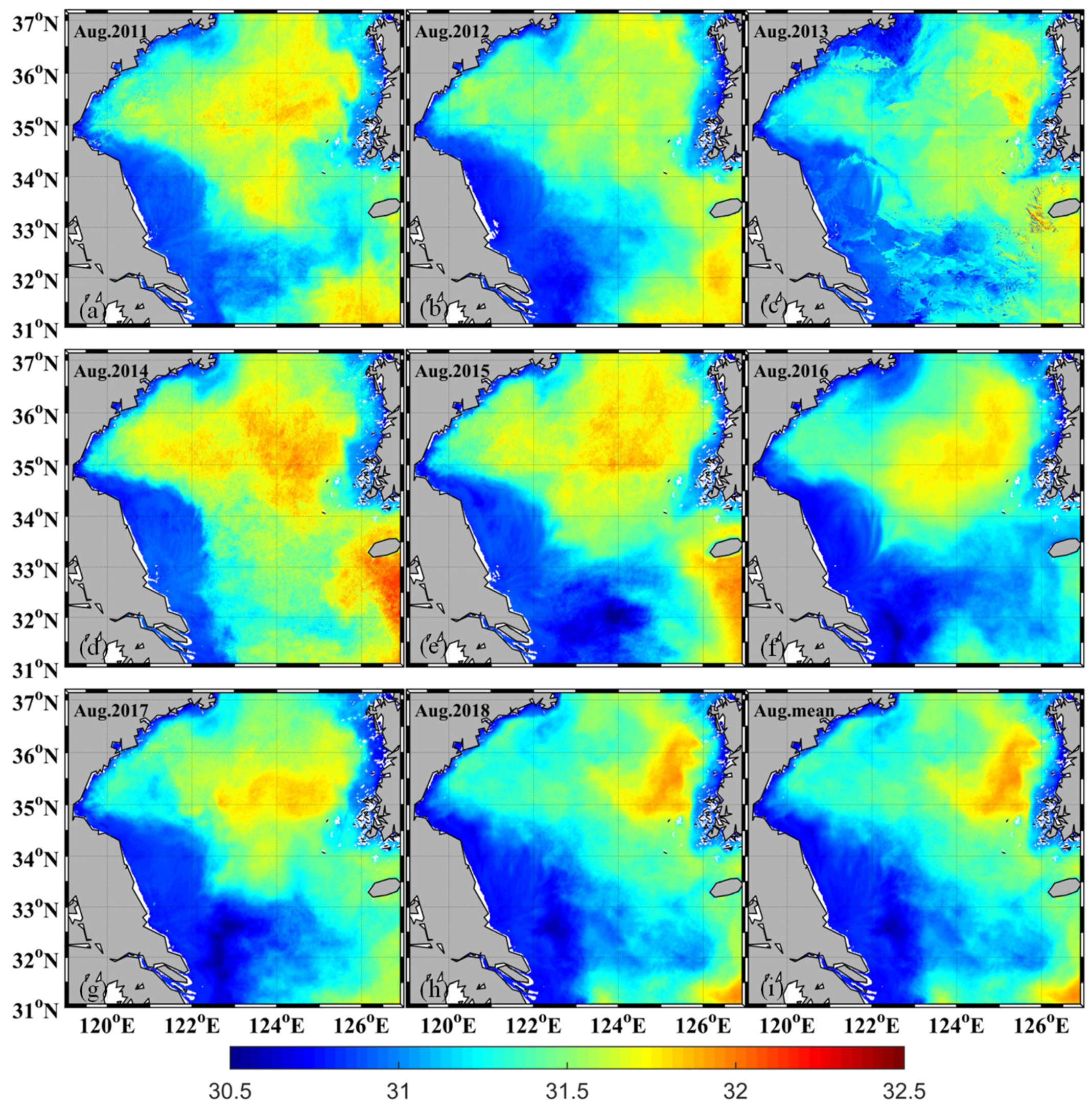

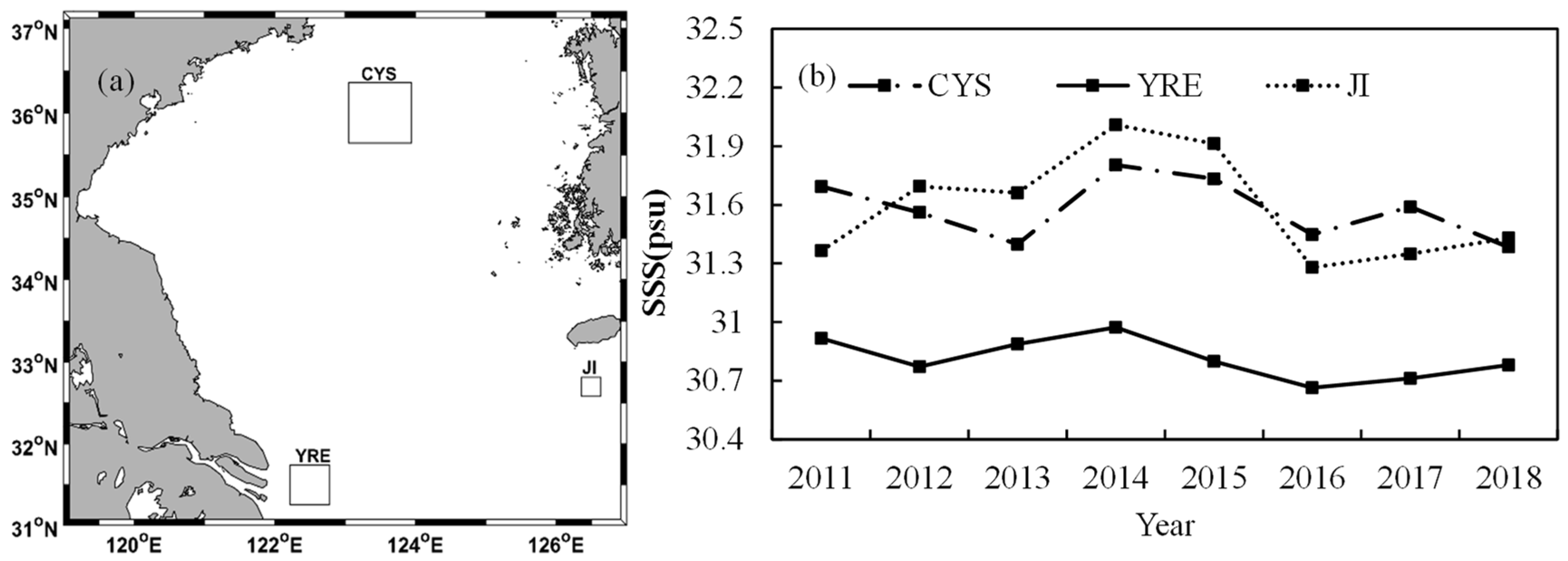
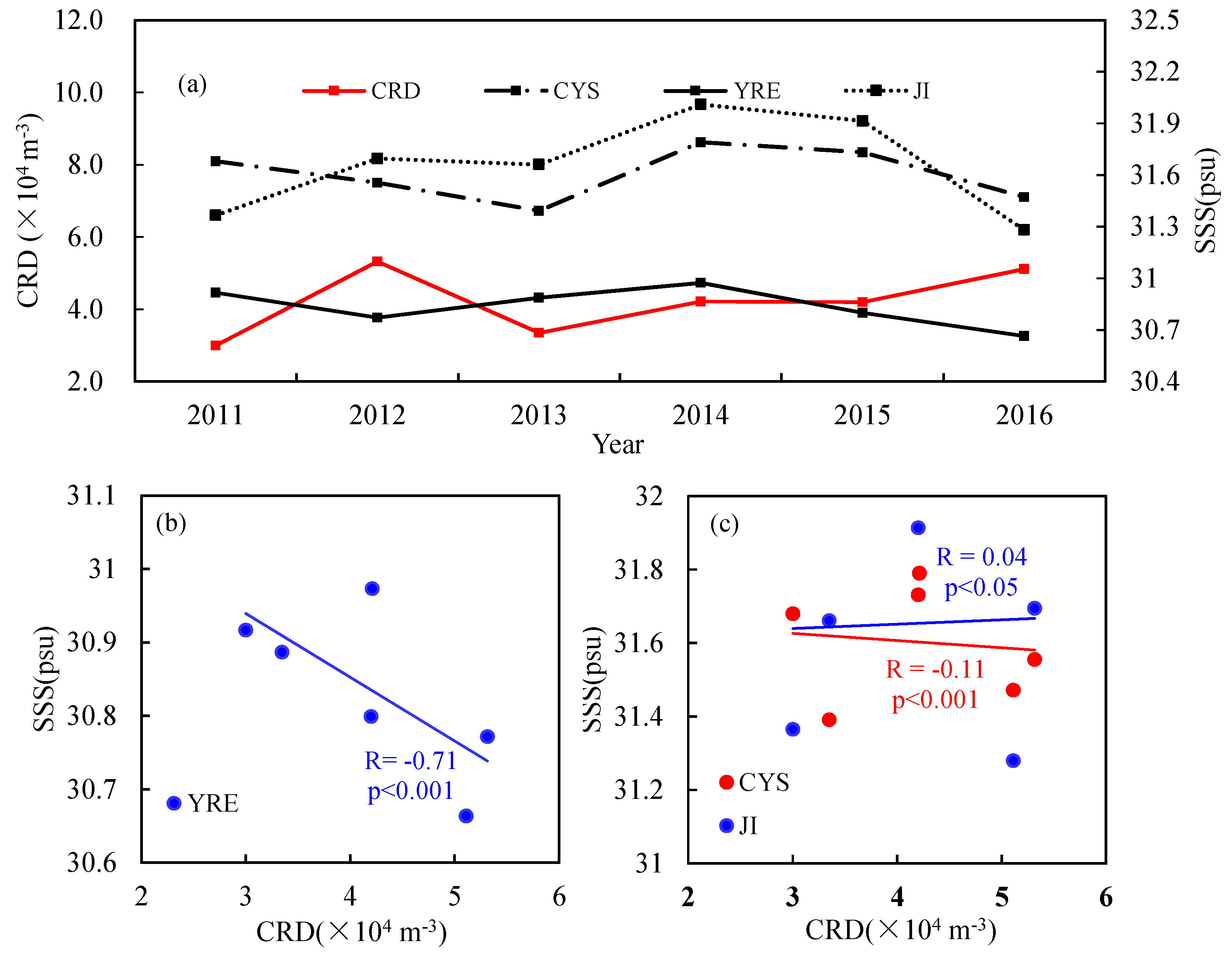
| X | General form | 6 GOCI channels |
|---|---|---|
| X1 | Rrs(λi) | i, j = 412, 443, 490, 555, 660, and 680 nm |
| X2 | log10Rrs(λi) | |
| X3 | Rrs(λi) − Rrs(λj) | |
| X4 | Rrs(λi)/Rrs(λj) | |
| X5 | log10Rrs(λi)/log10Rrs(λj) | |
| X6 | [Rrs(λi) − Rrs(λj)]/[Rrs(λi)/Rrs(λj)] | |
| X7 | [Rrs(λi) + Rrs(λj)]/[Rrs(λi)/Rrs(λj)] | |
| X8 | [Rrs(λi) − Rrs(λj)]/[Rrs(λi) + Rrs(λj)] | |
| X9 | k1 × Rrs(λ1) + k2 × Rrs(λ2) + … + ki × Rrs(λi) |
© 2019 by the authors. Licensee MDPI, Basel, Switzerland. This article is an open access article distributed under the terms and conditions of the Creative Commons Attribution (CC BY) license (http://creativecommons.org/licenses/by/4.0/).
Share and Cite
Sun, D.; Su, X.; Qiu, Z.; Wang, S.; Mao, Z.; He, Y. Remote Sensing Estimation of Sea Surface Salinity from GOCI Measurements in the Southern Yellow Sea. Remote Sens. 2019, 11, 775. https://doi.org/10.3390/rs11070775
Sun D, Su X, Qiu Z, Wang S, Mao Z, He Y. Remote Sensing Estimation of Sea Surface Salinity from GOCI Measurements in the Southern Yellow Sea. Remote Sensing. 2019; 11(7):775. https://doi.org/10.3390/rs11070775
Chicago/Turabian StyleSun, Deyong, Xiaoping Su, Zhongfeng Qiu, Shengqiang Wang, Zhihua Mao, and Yijun He. 2019. "Remote Sensing Estimation of Sea Surface Salinity from GOCI Measurements in the Southern Yellow Sea" Remote Sensing 11, no. 7: 775. https://doi.org/10.3390/rs11070775
APA StyleSun, D., Su, X., Qiu, Z., Wang, S., Mao, Z., & He, Y. (2019). Remote Sensing Estimation of Sea Surface Salinity from GOCI Measurements in the Southern Yellow Sea. Remote Sensing, 11(7), 775. https://doi.org/10.3390/rs11070775





